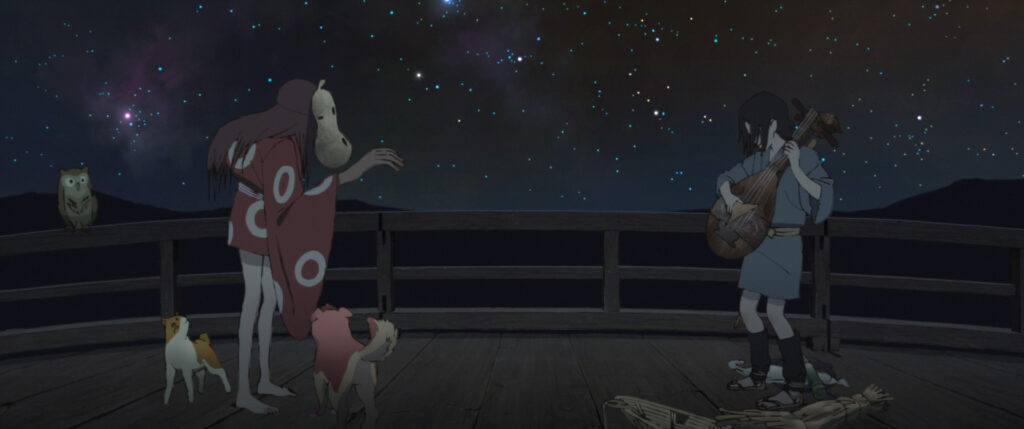animation, Avu-chan, Cory Yee, film festivals, Inu-Oh, Japan, Jason Marnocha, Joshua Waters, Kenjiro Tsuda, Keythe Farley, Masaaki Yuasa, Mirai Moriyama, movies, reviews, Sena Bryer, Tasuku Emoto, Venice International Film Festival, Yutaka Matsushige
December 20, 2022
by Carla Hay

Directed by Masaaki Yuasa
Available in the original Japanese version (with English subtitles) or in a dubbed English-language version.
Culture Representation: The Japanese animated film “Inu-Oh,” which takes place primarily in the 1300s, tells the story of a rock music duo that becomes popular, but secrets from their past affect their identities.
Culture Clash: The two musicians anger the ruling shōgun when the duo’s popular songs about historical events are rewritten versions of what the ruling power’s version of these events.
Culture Audience: “Inu-Oh” will appeal primarily to people who are interested in anime films that are compelling tales of non-conformity in the midst of pressure to conform.

“Inu-Oh” is an innovative reworking of a Japanese folk tale, with this anime movie making social commentary about what happens when two musicians from the 1300s give their own retelling of folk tales and suffer the consequences for it. The movie is filled with striking images, noteworthy original music, and a memorable story about identity and staying true to one’s self, even when there is pressure to change. Even though most of the film is set in the 14th century, the message is timeless. “Inu-Oh” had its world premiere at the 2021 Venice International Film Festival.
Directed by Masaaki Yuasa and written by Akiko Nogi, “In-Oh” is based on Hideo Furukawa’s historical novel “Tales of the Heike: Inu-Oh.” The title character of the “Inu-Oh” movie is the third son of a Noh dance troupe leader. Inu-Oh is treated like a freak because he was born with a deformed face, scaled-covered skin, a very long right arm, and his left arm and legs as stubs. Inu-Oh is forced to wear a mask in public. As a boy, his legs were restored when he learned how to dance by watching his father teach other people how to dance.
As an adult, Inu-Oh makes an unexpected friend named Tomona, who also has traumatic past related to his childhood. As shown in the beginning of the movie, agents of Ashikaga Yoshimitsu (based on the real person), the third shōgun of the Ashikaga shogunate that ruled from 1368 to 1394, ordered Tomona and his father to hunt for treasure underwater from shipwreck. The wrecked ship is from the defeated Heike people. Tomona and his father find the legendary Grasscutter Sword in a box on the ship. This magical sword, once uncovered, unleashes a force of energy that blinds Tomona and murders Tomona’s father in half by cutting him in half.
Tomona then goes on a quest that extends through his adulthood to find out exactly why this tragedy happened. He is accompanied by the ghost of his father. Tomona then meets a group of blind biwa players and joins this troupe. However, Tomona changes his name to Tomoichi, which makes it hard for his father’s spirit to know where Tomona/Tomoichi is.
Through a series of circumstances, Tomona/Tomoichi meets Inu-Oh. They decide to form a musical duo, with Inu-Oh as the snger/danger, and Tomona/Tomoichi as the biwa player. The movie puts a modern spin on the story by having the duo perform heavy metal music. The duo’s songs have lyrics that are revisions of folk tales.
This musical duo becomes so popular, large and rapturous crowds flock to see the performances. However, Ashikaga Yoshimitsu becomes upset because the lyrics do not conform to the official folk tales. The ruler is also worried that this musical duo will have too much influence over the masses and might prompt a revolution. And you can easily guess what might happen next when it’s decided that Inu-Oh and Tomona/Tomoichi are declared threats to the government.
The voices of the “Inu-Oh” characters are portrayed by different actors, depending on the version of “Inu-Oh.” The original Japanese version (with English subtitles) has Avu-chan (of the rock band Queen Bee) as the adult Inu-oh, Mirai Moriyama as Tomona, Tasuku Emoto as Yoshimitsu Ashikaga, Kenjiro Tsuda as Inu-Oh’s Father, and Yutaka Matsushige as Tomona’s Father. There’s also a U.S. version, with the dialogue dubbed in English, that has Joshua Waters as the adult Inu-oh, Sena Bryer as Tomona, Cory Yee as Yoshimitsu Ashikaga, Jason Marnocha as Inu-Oh’s Father, and Keythe Farley as Tomona’s Father.
In addition to having impressive animation, “Inu-Oh” skillfully explores themes of artistic freedom, as well as individuality versus society “norms.” The movie also respectfully handles disability issues without glossing over the prejudices experienced by disabled people. The music of Inu-Oh is catchy but might not be enjoyed as much by people who are inclined to dislike heavy metal. Overall, “Inu-Oh” is a creative triumph that anime fans will enjoy for how the movie uniquely combines ancient and contemporary storytelling.
GKIDS released “Ino-Oh” in select U.S. cinemas on August 12, 2022. The movie was released on digital and VOD on December 20, 2022, and is set for release on Blu-ray and DVD on January 24, 2023. “Inu-Oh” was released in Japan on May 28, 2022.
